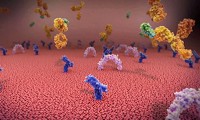-
Chi-Med Initiates Fruquintinib U.S. Clinical Trials
- Source: chi-med
- 669
- December 18, 2017
-
Magnetically Guided Bacteria Move Confidently Within Strong Currents, May Soon Deliver Drugs Inside Body
- Source: medgadget
- 426
- December 15, 2017
-
New Formulation of ONCASPAR®▼ (pegaspargase) Receives Marketing Authorization in Europe for Patients with Acute Lymphoblastic Leukemia (ALL)
- Source: Shire
- 608
- December 15, 2017
-
Bayer’s rivaroxaban submitted to U.S. FDA for approval in patients with coronary and/or peripheral artery disease
- Source: press.bayer
- 611
- December 15, 2017
-
Ionis Pharmaceuticals Licenses IONIS-HTT Rx to Partner Following Successful Phase 1/2a Study in Patients with Huntington’s Disease
- Source: finance.yahoo
- 485
- December 15, 2017
-
11 Brilliant Ways Therapists Control Their Holiday Stress
- Source: msn
- 378
- December 15, 2017
-
FDA approves first drug for Eosinophilic Granulomatosis with Polyangiitis, a rare disease formerly known as the Churg-Strauss Syndrome
- Source: Prnewswire;
- 489
- December 14, 2017
-
FDA suggests controls on interoperable devices
- Source: massdevice
- 568
- December 14, 2017
-
Bayer receives approval in China for Stivarga® (regorafenib) for the second-line systemic Treatment of liver cancer
- Source: investor.bayer
- 701
- December 14, 2017
-
‘Ground-breaking’ new drug gives hope in Huntington’s disease
- Source: in.reuters
- 575
- December 13, 2017
your submission has already been received.
OK
Subscribe
Please enter a valid Email address!
Submit
The most relevant industry news & insight will be sent to you every two weeks.













